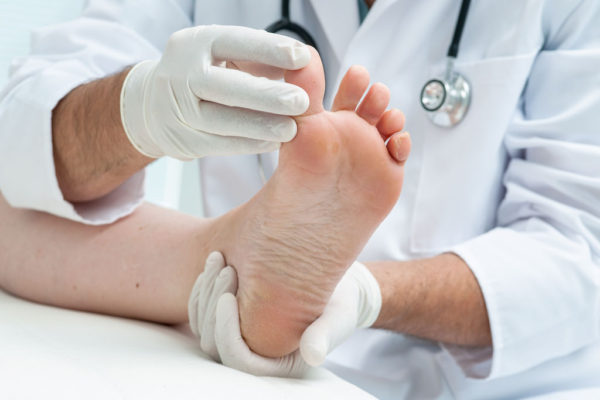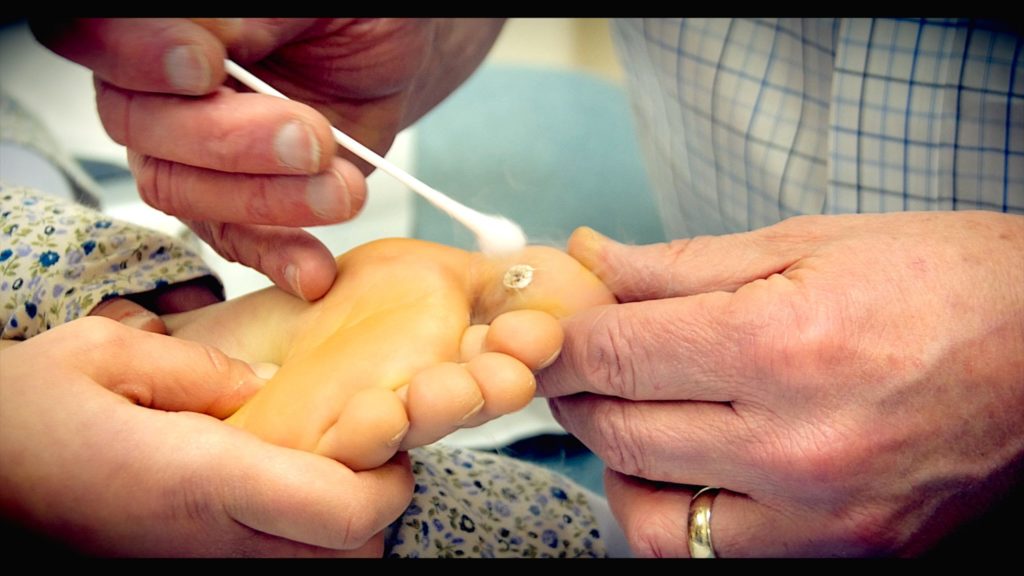Plantar Warts are small benign, well delimited rough growths that form in the epidermis (the outer layer of the skin). They generally measure a few millimeters in diameter but larger. The infection occurs as a result of a disease caused by a virus of the human papillomavirus (HPV) family and contagious. Most often, painless and do not necessarily need treatment. Children and adolescents are the most likely to affect. Warts usually appear on the fingers or feet, but they can also be seen on the face, back, or other parts of the body (elbows, knees). They form clusters of several clustered warts.
Plantar Warts Viral Infection: Types
There are several kinds of warts, depending on the type of papillomavirus involved. Their appearance also varies depending on where they are located. Here are the most common forms:
- The vulgar wart: this wart assumes the appearance of a hard and rough dome of flesh or grayish color. In general, it appears alone. It can form especially on the knees, elbows, and feet (toes), but more often on the hands and fingers. Rarely painful (except when located near or under the nails), it can, however, be troublesome.
- Plantar wart: As the name suggests, the plantar wart on the soles of the foot. It may go unnoticed for a while. On closer inspection, one can see a rough nodule. The plantar wart is painful due to the pressure exerted by the weight of the body. One may have the impression that it is deep, but it is always in the outer layer of the skin, the epidermis.
- Other types include, but are not limited to, filiform warts (on the eyelids and around the mouth in children), flat warts (usually grouped on the face, back of the hands and wrists), Myrmecia (on the soles of the foot, with blackheads), mosaic warts (under the feet)and warts (often on the scalp).
- Digitized warts result from the stacking of several warts, which forms a sort of tiny “cauliflower.”

Plantar Warts Viral Infection: Contagion
- Contamination can occur directly (skin to skin) or indirectly (by objects that have been in contact with infected skin, such as socks or shoes).
- Wet soils in swimming pools, public showers, beaches, and sports centers are particularly conducive to the transmission of plantar warts.
- In addition, some HPV can survive more than seven days on a dry surface.
The virus is introduced under the skin by a small fissure or wound, sometimes invisible to the naked eye. If the immune system does not neutralize the virus, it triggers a multiplication of cells in a specific place. Exposure to the virus does not automatically cause warts, as everyone’s immune system reacts differently and more or less effective in fighting the virus. On average, it takes two to six months between exposure to the virus and the onset of warts, called the incubation period. However, some warts may remain “dormant” for years.

Plantar Warts Viral Infection: Complications
Despite their unattractive appearance, warts are generally not serious. Even when scraped, they rarely become infected, but it’s recommended not to do so. Also, unless it is a plantar wart or located near a nail, they are usually painless. That said, some complications are still possible. The occurrence of one or more of the following symptoms should prompt a doctor:
- A wart that persists, multiplies or reappears despite home treatments
- A painful wart
- A wart under the nail or deforming the nail
- Bleeding
- A suspicious appearance, for in exceptional cases, a wart may prove malignant. Some skin cancers can also be mistakenly considered warts.
- Signs of infection, such as redness around the wart
- Propagation to other parts of the body
- Back pain or leg pain caused by a painful plantar wart (limping or bad positioning of the feet while walking)
- An embarrassment related to the location of the wart

Plantar Warts Viral Infection: Symptoms
- One or more small, rough and well-defined skin growths that usually appear on the hands, toes, soles of the foot, face, elbows, knees, or back.
- Small black spots appear in the outgrowth. These blackheads are not the “roots” of the wart, but rather small blood vessels that have formed due to the rapid growth of the wart.
- Sometimes itching
- Sometimes, a pain (especially in the case of the plantar wart)
Note. Plantar warts confused with corns. However, they are free from blackheads. In addition, the corns are usually on skin areas that are subjected to pressure or friction.
The doctor or dermatologist can make the right diagnosis.

Plantar Warts Viral Infection: People at Risk
- Children and adolescents, especially those who have a brother, a sister, classmates who have a wart
- People whose skin tends to dry out and crack, as well as those who suffer from excessive sweating of the feet.
- People with a weak immune system. In this case, the disease is caused in particular by a disease (cancer, HIV infection, etc.), or by drugs (including immunosuppressant). In addition, in these people, warts are often more challenging to treat.

Plantar Warts Viral Infection: Risk factors
For plantar warts only: walking barefoot in public places (swimming pools, locker rooms, public showers, beaches, sports centers, etc.).
Plantar Warts Viral Infection: The prevention of common and plantar warts
1. Basic measures to prevent warts
To prevent plantar warts, avoid walking barefoot in public places, especially in gymnasiums and showers, as well as around swimming pools.
2. To avoid contagion
- Cover warts with dressing during treatment.
- Wash hands after touching the wart or small skins.
- Avoid using towels and washcloths of a person with a wart.
- Be careful not to reuse a file or pumice that used to rub a wart.
- Do not scratch or bleed a wart.


